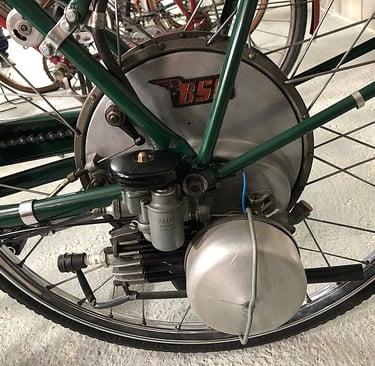The BSA Winged Wheel: Revolutionizing Personal Transport
The BSA Winged Wheel was a cyclemotor introduced in post-World War II Britain as an affordable and convenient mode of transport. It consisted of a small engine unit that could be attached to a traditional bicycle, transforming it into a motorized bike. The Winged Wheel had a 35cc two-stroke engine, provided 1 horsepower, and weighed approximately 26 pounds. It offered a simple and flexible transition between motorized and traditional cycling. The Winged Wheel became a cultural icon of post-war recovery and innovation, but its popularity declined with the emergence of more advanced transportation options. However, it left a lasting legacy in the evolution of motor-assisted bicycles and compact engines for personal transportation.
CYCLEMOTORSUNITED KINGDOM 1950'SBSA
12/26/20233 min read


The BSA Winged Wheel: Revolutionizing Personal Transport
Introduction
The BSA Winged Wheel represents a unique chapter in the history of personal transportation. As a fascinating hybrid of bicycle and motorbike, this cyclemotor offered post-war Britain an affordable and convenient mode of transport at a time when mobility was a much-needed commodity. This article embarks on a journey through time to explore the origins, design, and impact of the BSA Winged Wheel, highlighting its technological innovation and its enduring legacy in the annals of motoring history.
The Birth of the BSA Winged Wheel
Post-World War II Britain was a landscape of reconstruction and redevelopment, with a public eager to regain normalcy and facilitate mobility. The BSA Company, already renowned for its motorcycles, recognized the growing need for affordable personal transportation and responded with an innovative solution. In 1953, they introduced the BSA Winged Wheel, a cyclemotor that promised to revolutionize travel for the everyday individual. Unlike the motorcycles produced by BSA, the Winged Wheel was not just a vehicle, but a small engine unit designed to be fitted to the rear wheel of a traditional bicycle, transforming it into a motorized bike. This move blended the company's expertise in engineering with a keen insight into the market demand, aiming to provide a cost-effective and simple means for people to traverse the cities and countryside.
Design and Specifications
At the heart of the BSA Winged Wheel was its neatly packed 35cc two-stroke engine, which provided a modest 1 horsepower at 6000 rpm. This power output was humble by today's standards but was more than sufficient for the lightweight setup it was intended for. The unit itself weighed approximately 26 pounds (around 12 kilograms), making it a relatively light addition to a standard bicycle. The engine featured a direct drive to the rear wheel, and the fuel was a simple petrol/oil mixture, typical of two-stroke engines of that era. Its design stood out for its practicality; the entire power pack could be attached to or removed from the bicycle with relative ease, allowing for a flexible transition between motorized and traditional cycling. The Winged Wheel also boasted features like an idling function, which enabled the rider to pedal without engine resistance when the motor was not needed, furthering its utility and appeal.
Riding the Winged Wheel
For those lucky enough to experience it, riding a bicycle equipped with the BSA Winged Wheel was an exercise in simplicity and convenience. The process of converting a conventional bicycle into a motor-assisted one was straightforward, with the Winged Wheel unit replacing the bike's rear wheel. Riders enjoyed the added boost of power, which was particularly useful for tackling hills or making longer commutes manageable. Despite its modest power, the Winged Wheel could propel a rider at speeds of around 20 miles per hour, depending on the terrain and weight of the cyclist. Furthermore, the ease with which the motor could be switched off allowed cyclists to revert to traditional pedaling, offering a dynamic riding experience that could switch between motorized assistance and human power as needed.
The Cultural Impact and Popularity
The BSA Winged Wheel did not merely serve as another transportation option; it became a cultural icon synonymous with post-war recovery and innovation. Its introduction came at a time when Britain was keen on reinvigorating its industrial prowess, and the Winged Wheel was a testament to that spirit. It provided a sense of freedom and autonomy to a war-weary populace, offering an inexpensive and efficient means of travel. Although the cyclemotor never achieved the widespread popularity of motorcycles or cars, it carved out a niche for itself among cycling enthusiasts and tech-savvy individuals who appreciated its engineering cleverness. The Winged Wheel became a symbol of the era's ingenuity, encapsulating a period when necessity drove inventive solutions in personal transportation.
Decline and Legacy
Despite its initial promise, the BSA Winged Wheel's time in the spotlight was relatively brief. New advances in transportation such as mopeds, which offered more power and comfort, quickly overshadowed cyclemotors. These competitors offered integrated designs that were more convenient and practical, posing a significant challenge to the add-on nature of the Winged Wheel. As a result, production ceased in the late 1950s, but the Winged Wheel's influence did not wane. It left an indelible mark on the evolution of motor-assisted bicycles and inspired future generations of innovations in compact, efficient engines for personal transportation. Today, the BSA Winged Wheel remains a cherished collectible for vintage cycling and motorcycling enthusiasts, celebrated for its role in bridging the gap between purely human-powered bicycles and fully motorized vehicles.
